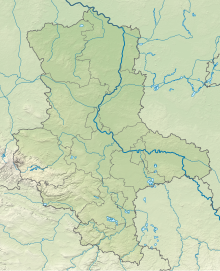Taufwiesenberge
Coordinates: 52 ° 14 ′ 35 ″ N , 11 ° 43 ′ 10 ″ E
The Taufwiesenberge are a nature reserve in the unified municipality of Möser in the Jerichower Land district in Saxony-Anhalt .
The nature reserve with the registration number NSG 0189 is around 40 hectares in size. It is largely part of the FFH area “Elbaue south of Rogätz with the mouth of the ear” and the bird sanctuary “Elbaue Jerichow”. The nature reserve is the conservation area surrounded "Umflutehle-Külzauer Fort". It has been under protection since 1999 (date of regulation: November 15, 1999). The responsible lower nature conservation authority is the district of Jerichower Land.
The nature reserve is located northeast of Magdeburg in the Middle Elbe Biosphere Reserve . It is species-rich dry and neglected grassland Mbereiche on a Dünenzug in Elbaue and three caused by sand mining Abgrabungsgewässer, which adjoin the Dünenzug, under protection. To the southwest, a former military training area connects to the dunes, which is also part of the nature reserve. The embankment of the former Berlin railway runs between the excavation waters and the dunes. To the southwest this dam forms the boundary of the nature reserve.
On the summit and the southeast slope of the Taufwiesenberge itself, there is a light pine forest with Scots pine , silver birch and aspen . The open areas are occupied by dry sandy lawns with areas free of vegetation, pioneering stages and fragments of lichen-rich silvergrass as well as sandy grasslands interspersed with hawthorn and rose bushes and Scots pine. It is worth mentioning the occurrence of apple rose .
Succession leads to spurge rich heather fragments in the area of the nature reserve. The late blooming bird cherry penetrates the protected area and causes the open areas to be covered with bushes . Land equestrian grass settles on partial areas and displaces less competitive species.
The bank areas of the excavation waters are occupied by reed beds with narrow-leaved cattails and reeds as well as bushes with narrow-leaved olive willow . Here are u. a. Brown syphoid grass , divine mercury and in the excavation waters to find Ähriges thousand-leaf .
The dry locations in the reserve provide a suitable habitat for numerous animals, including grasshoppers such as the blue-winged wasteland and blue-winged sand hedge , ant lion , various spiders , birds including the curlew , hoopoe , great gray shrike and long-eared owl . In the area of Abgrabungsgewässer different are dragonflies , including Southern Emerald Damselfly and Little Emperor Dragonfly , amphibians such as fire-bellied toad and natterjack toads and birds such as red-necked grebe , reed warbler , Beutelmeise and sand martin home.
Almost 22 hectares in the area of the former military training area belong to the NABU Foundation National Natural Heritage , which grazes it for maintenance.
literature
- Michael Unruh: On the spider fauna of the NSG "Taufwiesenberge" near Hohenwarthe (Jerichower Land district) . In: Nature Conservation in the State of Saxony-Anhalt , Nature Conservation in the State of Saxony-Anhalt, Volume 49, 2012, pp. 14–25 ( PDF file , 3.2 MB).
- Falko Heidecke, Heidrun Heidecke: The Taufwiesenberge - a forgotten protected area between gravel extraction and renaturation . In: Bulletin of the AG Odonatenfaune Sachsen-Anhalt of the Entomologists Association Sachsen-Anhalt e. V. , No. 5, December 2004 ( PDF file , 281 kB).
Web links
- Taufwiesenberge. State administrative office of Saxony-Anhalt
- The Taufwiesenberge nature reserve. NABU Foundation for National Natural Heritage
Individual evidence
- ↑ Taufwiesenberge. NABU Foundation for National Natural Heritage. Retrieved June 6, 2014.



